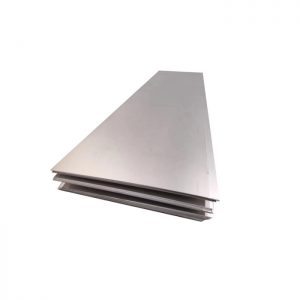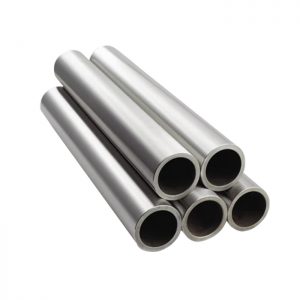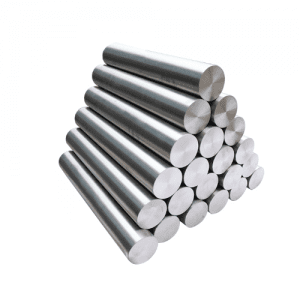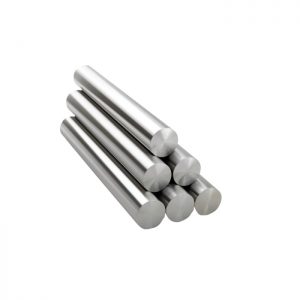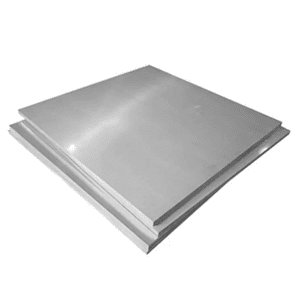Titanium and Titanium Alloy in the Aerospace Sector
Early Applications of Titanium in Aerospace Development
Titanium alloy materials used in aviation and aerospace, known as titanium alloy castings, have extensive applications. These include joints, rivets, and cast parts. In aircraft manufacturing, titanium alloys are primarily used in engine compressor components, rocket development, and certain weapon structural parts. By the mid-21st century, titanium and its alloys had become widely used in general industrial fields.
Innovation in Aircraft Frames with Titanium Alloys
Titanium alloy is a new and significant structural material in the aerospace industry. Its density and operating temperature lie between those of aluminum and steel, but it has a higher strength-to-weight ratio excellent corrosion resistance to seawater, and superb low-temperature performance.
- 1960s Onwards: The use of titanium alloys expanded from the rear fuselage to the mid-fuselage, partially replacing structural steel to manufacture critical load-bearing components like bulkheads, beams, and flap tracks.
- National Defense: With the continuous buildup of national defense, the amount of titanium alloy used in military aircraft rapidly increased. Titanium alloys now account for 20% a 25% of the total weight of aircraft structures.
- Civilian Aircraft: Over time, civilian aircraft also began to use titanium alloys extensively. For example, the Boeing 747 uses over 3,600 kg of titanium.
- High-Speed Aircraft: The U.S. SR-72 series high-altitude, high-speed reconnaissance aircraft, which flies at Mach 3.0 and reaches an altitude of 26,200 meters, relies heavily on titanium alloys, making up 91% of its structural weight, earning it the nickname “all-titanium” aircraft.
Titanium Alloy Compressors
- Increased Temperatures: When the thrust-to-weight ratio of aero-engines increased from 4-6 a 8-10, the temperature at the compressor outlet also increased from 200°C-300°C to 500°C-600°C. Thus, low-pressure compressor discs and blades, previously made of aluminum, had to be replaced with titanium alloys.
- Replacement of Stainless Steel: Titanium alloys were used instead of stainless steel to make high-pressure compressor discs and blades, reducing the aircraft’s structural weight.
- 1970s Onwards: Titanium alloys generally accounted for 20% a 30% of the structural weight of aero-engines, mainly used in compressor components such as forged titanium fans, compressor discs and blades, cast titanium compressor casings, intermediate casings, and bearing housings.
- Spacecraft: Titanium alloys are used for their high strength-to-weight ratio, corrosion resistance, and low-temperature performance to manufacture pressure vessels, fuel tanks, fasteners, instrument bands, frames, and rocket shells. Titanium alloy sheets are also used in welded parts of artificial satellites, lunar modules, manned spacecraft, and space shuttles.
Applications of Titanium Alloy Spinning Parts
In aerospace, titanium alloys are used in spacecraft systems not only for their strong structural characteristics and excellent physical properties but also for their lightweight and precision.
- New Spinning Parts: The quality and reliability of new titanium alloy spinning parts require multiple experimental data analyses. Due to the complexity of forming titanium alloy sheets, TC4 is used as the base material, combining ordinary and powerful spinning methods to manufacture new semi-spherical titanium alloy parts.
- Materials: TC3 and TC4 are also used as materials for titanium alloy sheets, and hot spinning is used to produce two new types of titanium alloy hemispheres.
Applications in Gas Turbine Engines
Another major application of titanium alloys in aerospace is in aircraft engine manufacturing.
- Current Usage: About one-third of the structural weight of gas turbine engines used in modern aircraft in China is made up of titanium alloys.
- Early Applications: As early as the 1940s and 1950s, industrially advanced countries such as the United States and the United Kingdom applied titanium alloy technology to improve the structural components of jet engines during early aircraft production.
- Initial Components: The first titanium alloy engine components were compressor blades, followed by the rapid development of titanium alloy compressor discs. Nowadays, most fan blades used in jet engines are made of new titanium alloys.
Applications of High-Temperature Titanium Alloys
Due to their strong thermal strength and high strength-to-weight ratio, high-temperature titanium alloys are widely used in aero engines.
- Primary Uses: They are primarily used in engine fans, blades, precision instruments, and navigation devices.
- Replacement of Nickel-Based Superalloys: Replacing existing nickel-based superalloys with titanium alloys reduces the structural weight of compressors by 30% a 35%.
- Comprehensive Titanium Alloy System: Over the years, to meet the demands of high-performance engines, a comprehensive titanium alloy system has been developed.
| Airframe components | Titanium Sheets, Plates, Fasteners (bolts, nuts, screws), Calificación 2, Calificación 5 |
| Jet engines | Tubos de titanio, Fasteners (bolts, nuts, screws), Calificación 5 |
| Helicopter rotor blades | Tubos de titanio, Calificación 5 |
| Spacecraft | Titanium Sheets, Plates |
Recommended Titanium Alloy Materials Product
Titanium and Titanium Alloy in the Medical Sector
Artificial Hip Joints
- Descripción:
- A type of prosthetic joint designed to mimic the human hip structure.
- Components:
- Metal rod inserted into the upper end of the thigh bone with a metal ball at the top.
- Plastic socket adhered to the hip bone into which the metal ball fits.
- Usage:
- Widely used with tens of thousands of patients fitted with these joints.
- Materials:
- Commonly used material: Titanium alloy.
- Manufacturing methods:
- Titanium alloy: Hot isostatic pressing.
- Cobalt-chromium-molybdenum alloys: Casting.
- Stainless steel: Forging.
- Final products are machined and surface-treated.
Titanium Alloy Porcelain Teeth
- Descripción:
- Intermediate materials between precious metal porcelain teeth and nickel-chromium alloy porcelain teeth.
- Advantages:
- Good biocompatibility.
- Strong bond between titanium alloy and ceramic.
- Resistance to chipping and durability.
- Typically does not cause discoloration of surrounding tissues.
- Disadvantages:
- The inner crown has a gray metal color.
- Slight bluish tint under certain lighting conditions.
- Less aesthetically pleasing.
Titanium Alloy Frameworks
- Advantages:
- High strength.
- Smooth surface.
- Wear resistance.
- Corrosion resistance.
- Permanent repair capabilities.
- Composición:
- Typically contains 46% titanio.
- Biocompatibility was comparable to 75% gold alloy.
- Aplicaciones:
- Quick restoration of chewing function.
- Minimal discomfort and strong retention.
- Suitable for fixed prosthetics.
- Ideal for individuals sensitive to nickel ions.
- Widely used in the restoration of anterior teeth.
Applications of Titanium Materials in the Pharmaceutical Industry
- Uses:
- Manufacturing containers, reactors, and heaters.
- Challenges in Production:
- Equipment frequently contacts inorganic acids, organic acids, and their salts.
- Corrosion damage and iron ion contamination from steel equipment affect product quality.
- Solutions:
- Titanium equipment prevents corrosion and contamination issues.
- Examples: Penicillin esterification kettles, saccharification tanks, chloramphenicol film evaporators, metamizole reactors, Metol filters, dimethyl sulfate coolers, and drug solution filters.
- Benefits:
- Improved quantity and quality of drug solutions.
- Compliance with Chinese Pharmacopoeia standards.
Surface Modification of Medical Pure Titanium and Titanium Alloys
- Purpose:
- To improve wear resistance, corrosion resistance, and biological properties (biocompatibility and bioactivity) of implants.
- Challenges:
- The elastic modulus of titanium alloys is much higher than that of bone, causing mechanical mismatches.
- Different composition from natural bone.
- Biocompatibility:
- Good biocompatibility with no fibrous encapsulation around the implant.
- Integration with bone is more mechanical interlock rather than a strong chemical bond.
| Medical (implants) | Titanium Rods, Bars, Alloys (Calificación 5 preferred), Calificación 5 |
| Medical (instruments) | Titanium Rods, Bars |
Recommended Titanium Alloy Materials Product
Titanium and Titanium Alloy in Chemical Processing
Applications of Titanium in the Fertilizer Industry
- Urea Production:
- Corrosive Medium: Ammonium carbamate, excess ammonia, urea, and water at high temperatures and pressures.
- Required Equipment: Titanium is used for high-pressure equipment like synthesis towers, CO₂ strippers, and first-stage separators in contact with molten urea due to its superior resistance to localized corrosion compared to stainless steel.
- Example: Urea stripping towers are among the heavy-duty titanium-lined equipment designed and manufactured domestically.
- Combined Alkali Production:
- Corrosive Medium: High concentration ammonium chloride solution.
- Required Equipment: Only titanium can effectively solve the corrosion issues in combined alkali production, where coating protection is inadequate.
- Aplicaciones: Titanium and titanium alloys are used for valve plates, springs in chemical installations like high-pressure compressors for hydrogen and nitrogen, and anode materials for electrochemical cathodic protection to enhance fatigue corrosion resistance and lifespan.
Applications of Titanium in the Chlor-Alkali Industry
- Corrosion Resistance: Titanium’s exceptional resistance to wet chlorine gas, chlorides, and chlorine-containing solutions, without pitting or stress corrosion, makes it invaluable in chlor-alkali production.
- Key Equipment:
- Wet chlorine coolers
- Metal anodes in electrolyzers
- Dechlorination tower heating tubes
- Pumps and valves for vacuum dechlorination of chlorine-containing brine
- Benefit: Titanium has resolved long-standing corrosion issues in chlor-alkali plants, making this industry one of the largest users of titanium equipment.
Applications of Titanium in the Synthetic Fiber Industry
- Corrosive Medium: Processes involving halogen compounds (chlorides, bromides) as catalysts or intermediates.
- Required Equipment: Titanium is used for key equipment to combat severe corrosion.
- Examples:
- Oxidation towers in polyester production
- Photochemical reactors in ε-caprolactam production
- Intermediate heaters in disalt hydrolysis
- Hydroxylamine heat exchangers
- Oxidation reactors in vinyl acetate production
Applications of Titanium in Dye and Pesticide Production
- Corrosive Medium: Various acids and alkalis during the production of dyes, pesticides, and intermediates.
- Required Equipment: Titanium and titanium alloys are used to overcome severe equipment corrosion, reduce maintenance frequency, and extend service life.
- Examples:
- Azeotropic towers and evaporators in maleic anhydride production
| Chemical Processing | Titanium Sheets, Plates, Tubes, Pipes, Bobinas, Foils, Flanges, Fittings, GrTypade 2 |
Recommended Titanium Alloy Materials Product
Titanium and Titanium Alloy in the Marine Engineering
Pressure Hulls
- High Specific Strength: Titanium alloys are the preferred material for deep-sea equipment pressure hulls due to their high specific strength, excellent corrosion resistance, and non-magnetic properties.
- Early Adoption: Russia was the first country to use titanium alloy pressure hulls in nuclear submarines, with the “Alpha” y “Typhoon” class submarines extensively utilizing titanium.
- Chinese Innovation: China’s independently developed “Jiaolong” manned submersible also uses titanium alloy for its pressure hull, underscoring titanium’s critical role in deep-sea exploration.
Propulsion Systems
- Corrosion Fatigue Resistance: Titanium alloy propellers are ideal for ships due to their high corrosion fatigue strength and cavitation resistance.
- Historical Usage: Since the 1960s, countries like Russia and the UK have used titanium alloy propellers on ships. The US Navy’s experimental submarine hunters and large military hydrofoil boats also adopted titanium alloy propellers.
- Engine Applications: Titanium alloys are used in ship engines and waterjet propulsion systems. Por ejemplo, Russia’s nuclear-powered icebreakers use steam engines with titanium alloys, while the US SES-100A experimental boat and Japan’s “PT-10” torpedo boat use waterjet propulsion systems made from industrial pure titanium and titanium alloy forgings.
Pumps, Valves, and Pipelines
- Marine Environment Challenges: Shipboard pumps, valves, pipelines, and accessories face harsh marine conditions.
- Material Requirements: Due to copper alloys’ susceptibility to corrosion in marine environments, titanium alloys are the ideal replacement.
- Longevity and Efficiency: Using titanium alloys for these components significantly enhances the ship’s pipeline system’s lifespan and efficiency.
Acoustic Devices
- Sonar Systems: Titanium alloys are used to manufacture acoustic devices like sonar systems due to their low density, low sound velocity, and excellent acoustic impedance matching properties.
- Improved Detection: These properties enhance the detection accuracy and sensitivity of acoustic devices.
Electronic Information Systems
- Component Durability: Titanium alloys play a vital role in shipboard electronic information systems, used for making enclosures, heat sinks, and other parts.
- Stable Operation: These components ensure the stable operation of electronic equipment in harsh marine environments.
Structural Materials
- High Specific Strength and Lightweight: Titanium alloys are ideal for ship structural materials due to their high specific strength and lightweight properties.
- Structural Applications: They can be used to manufacture the ship’s framework, decks, and hull components, effectively reducing the ship’s overall weight and enhancing its navigation performance.
| Marine Engineering | Titanium Sheets, Plates, Rods, Bars, Tubes, Pipes, Flanges, Fittings, Calificación 2 |
Recommended Titanium Alloy Materials Product
-
 Suministro de tamaño OEM de stock de brida de titanio
Suministro de tamaño OEM de stock de brida de titanio -
 Tamaño estándar de stock de tubería de titanio y suministro OEM
Tamaño estándar de stock de tubería de titanio y suministro OEM -
 Tamaño estándar de stock de barra de varilla de titanio y suministro OEM
Tamaño estándar de stock de barra de varilla de titanio y suministro OEM -
 Tamaño estándar de stock de placa de titanio y suministro OEM
Tamaño estándar de stock de placa de titanio y suministro OEM -
 Tamaño estándar de stock de láminas de titanio y suministro OEM
Tamaño estándar de stock de láminas de titanio y suministro OEM -
 Tamaño estándar de varilla de titanio y suministro OEM
Tamaño estándar de varilla de titanio y suministro OEM -
 Tamaño estándar en stock de tubos de titanio y suministro OEM
Tamaño estándar en stock de tubos de titanio y suministro OEM
Titanium and Titanium Alloy in Automotive
Titanium Alloy Engine Connecting Rods
- Lightweight: Using titanium alloy for connecting rods is highly rational due to its lightweight properties. Compared to steel connecting rods, titanium alloy rods can reduce weight by 15%-20%.
- Early Adopters: The Ferrari 315LV8 was the first car to use titanium alloy connecting rods.
Engine Valves
- Lightweight and Durable: Titanium alloy engine valves are lighter, have a longer lifespan, and can reduce fuel consumption.
- Comparison to Steel: Titanium alloy valves reduce mass by about 30%-40% compared to steel, allowing the engine’s maximum RPM to increase by approximately 20%.
Valve Spring Retainers
- Strength and Fatigue Resistance: The high strength and fatigue resistance of titanium alloy make it ideal for valve spring retainers.
- Weight Reduction: Titanium alloy retainers are 30%-40% lighter than steel, reducing the inertia mass of the valve assembly and increasing the engine’s maximum RPM.
Titanium Alloy Springs
- Elastic Modulus: Titanium alloy springs have a lower elastic modulus than steel springs.
- Space and Weight Savings: They provide the same elasticity at only 40% of the height and 30%-40% of the weight of steel springs, offering more design space and longer lifespan.
Turbocharger Rotors
- Heat Resistance and Machinability: Titanium alloy turbocharger rotors perform well under high temperatures and are easy to manufacture.
- High-Temperature Performance: These rotors operate efficiently at temperatures up to 850°C, showcasing the capabilities of titanium alloys.
Exhaust Systems and Mufflers
- Performance and Lifespan: Titanium alloy exhaust systems enhance performance, longevity, and aesthetics while improving fuel combustion efficiency.
- Weight Reduction: Titanium exhaust systems are approximately 40% lighter than steel, reducing the vehicle’s weight by about 5 kilograms.
Vehicle Frame
- High Strength and Toughness: Some titanium alloys are ideal for vehicle frames due to their high strength and toughness.
- Enhanced Driving Experience: Japanese manufacturers use titanium for vehicle frames to provide a better driving experience.
Titanium Alloy Wheel Hub Bolts
- Lightweight and Strong: Essential for modified wheel hubs, titanium alloy bolts are lighter and stronger than steel bolts.
- Aesthetic Appeal: Their unique luster enhances the appearance of wheel hubs.
Other Titanium Alloy Components
- Diverse Applications: Titanium is also used in various other components, including:
- Engine rocker arms
- Suspension springs
- Engine piston pins
- Fasteners
- Hanger nuts
- Door intrusion beams
- Car stand brackets
- Brake caliper pistons
- Pivot pins
- Pressure plates
- Gear shift buttons
- Clutch discs
| Automotive (parts) | Rods, Bars, Tubes, Fasteners (bolts, nuts, screws), Alloys, Calificación 5 (for high-strength parts) |
